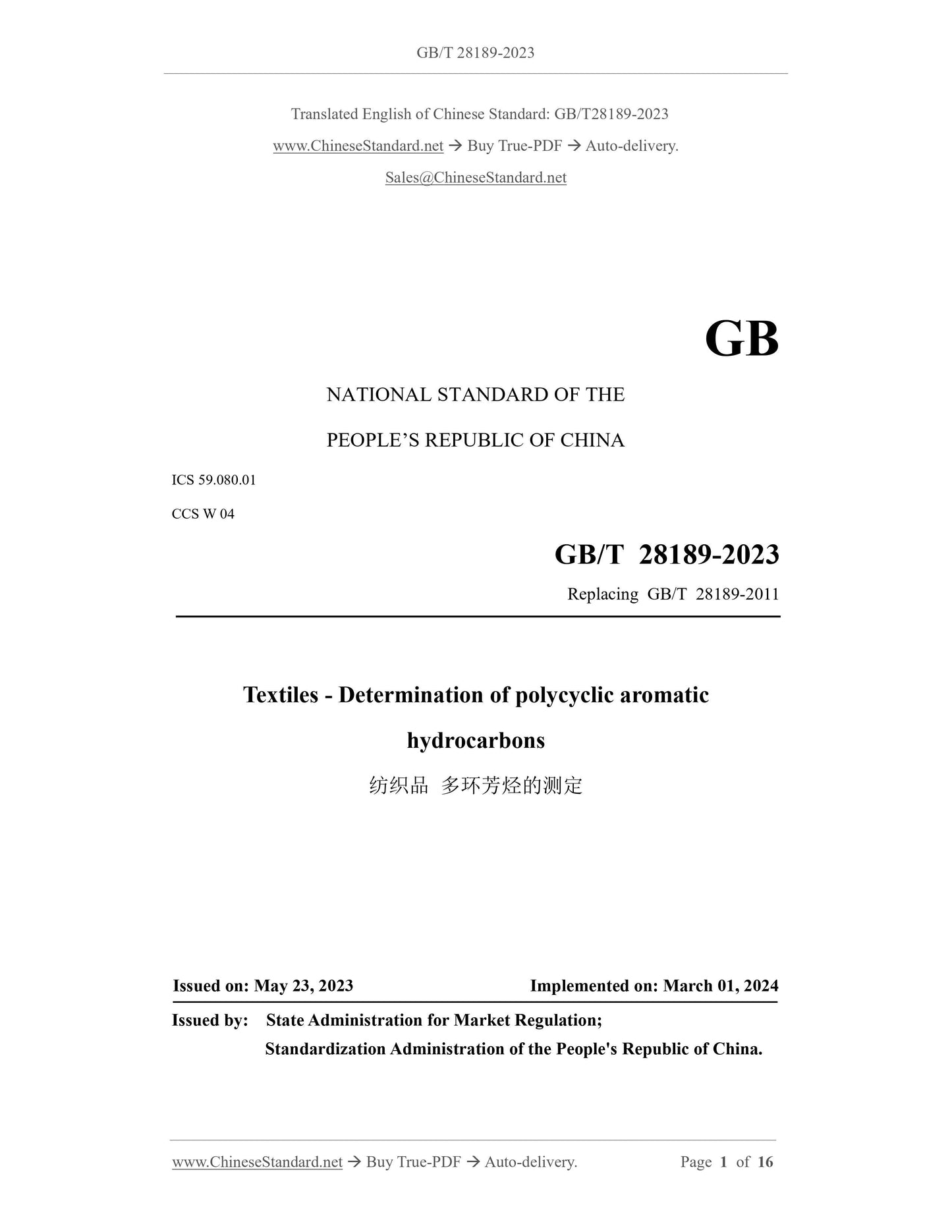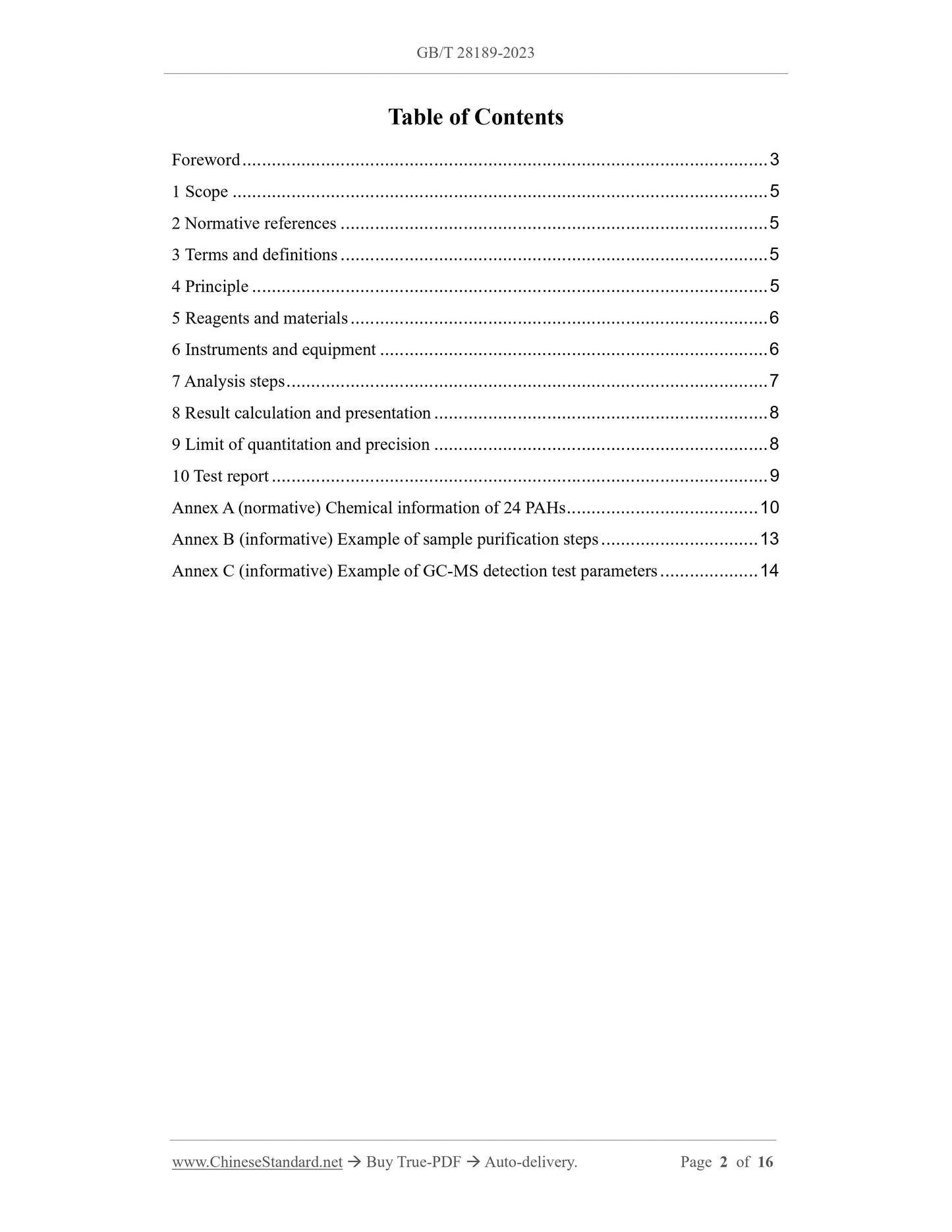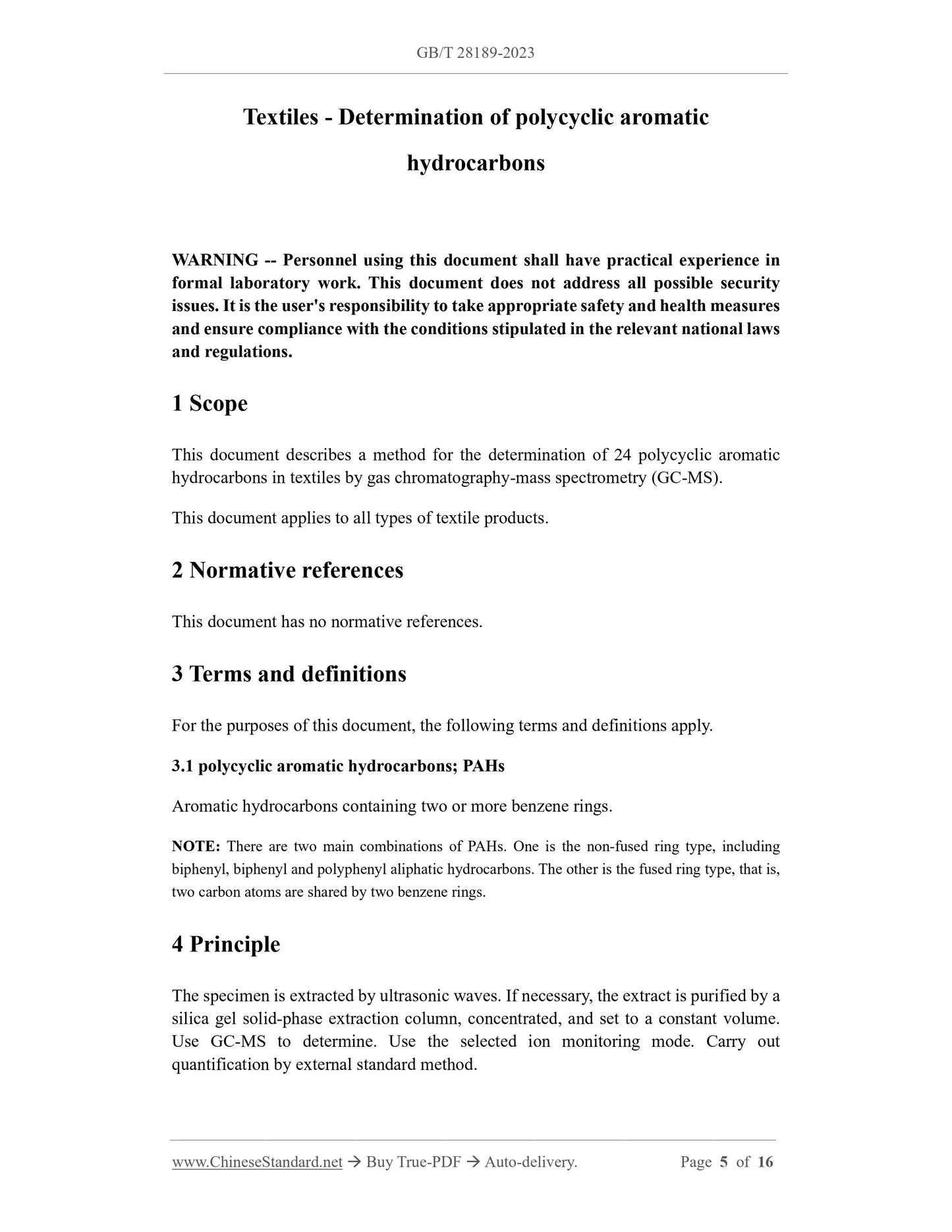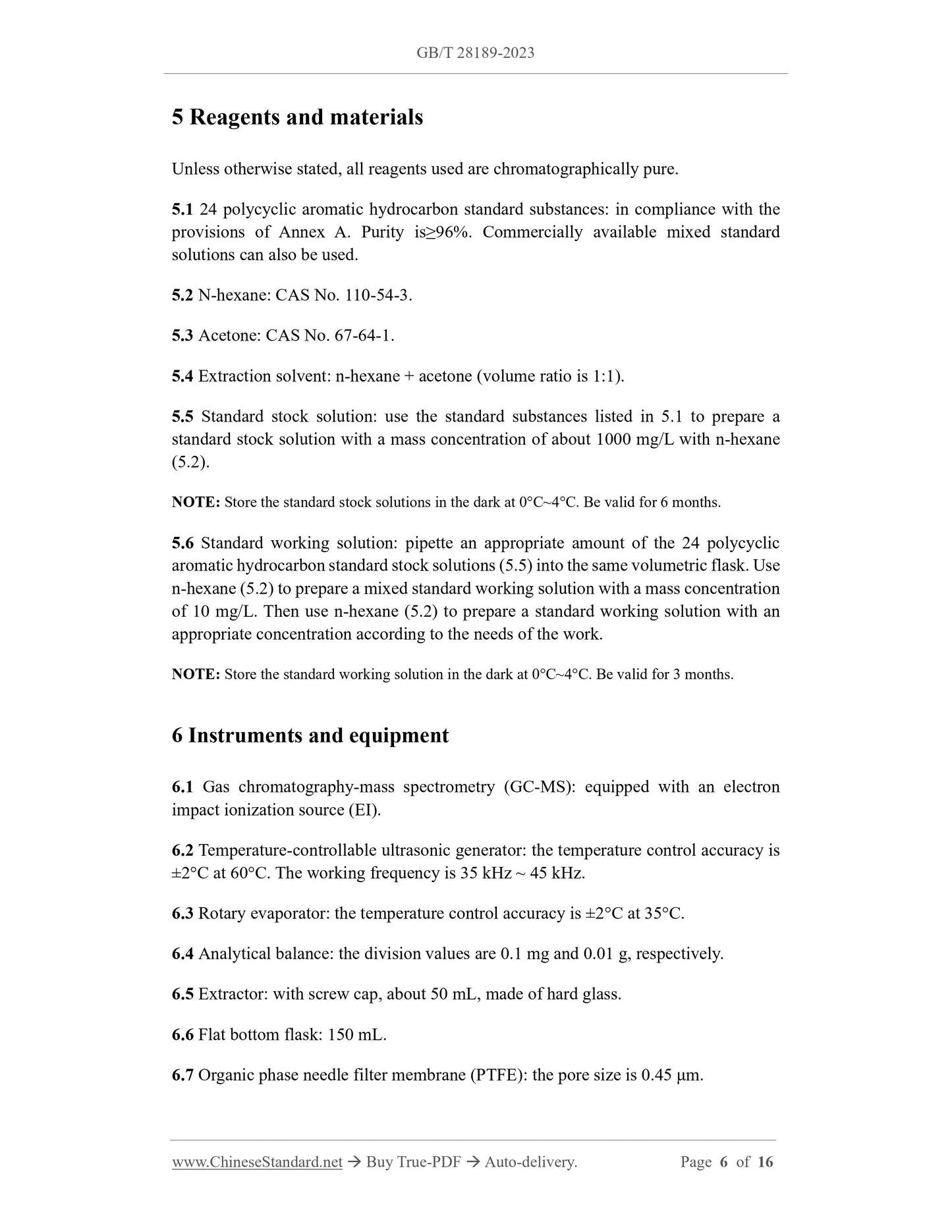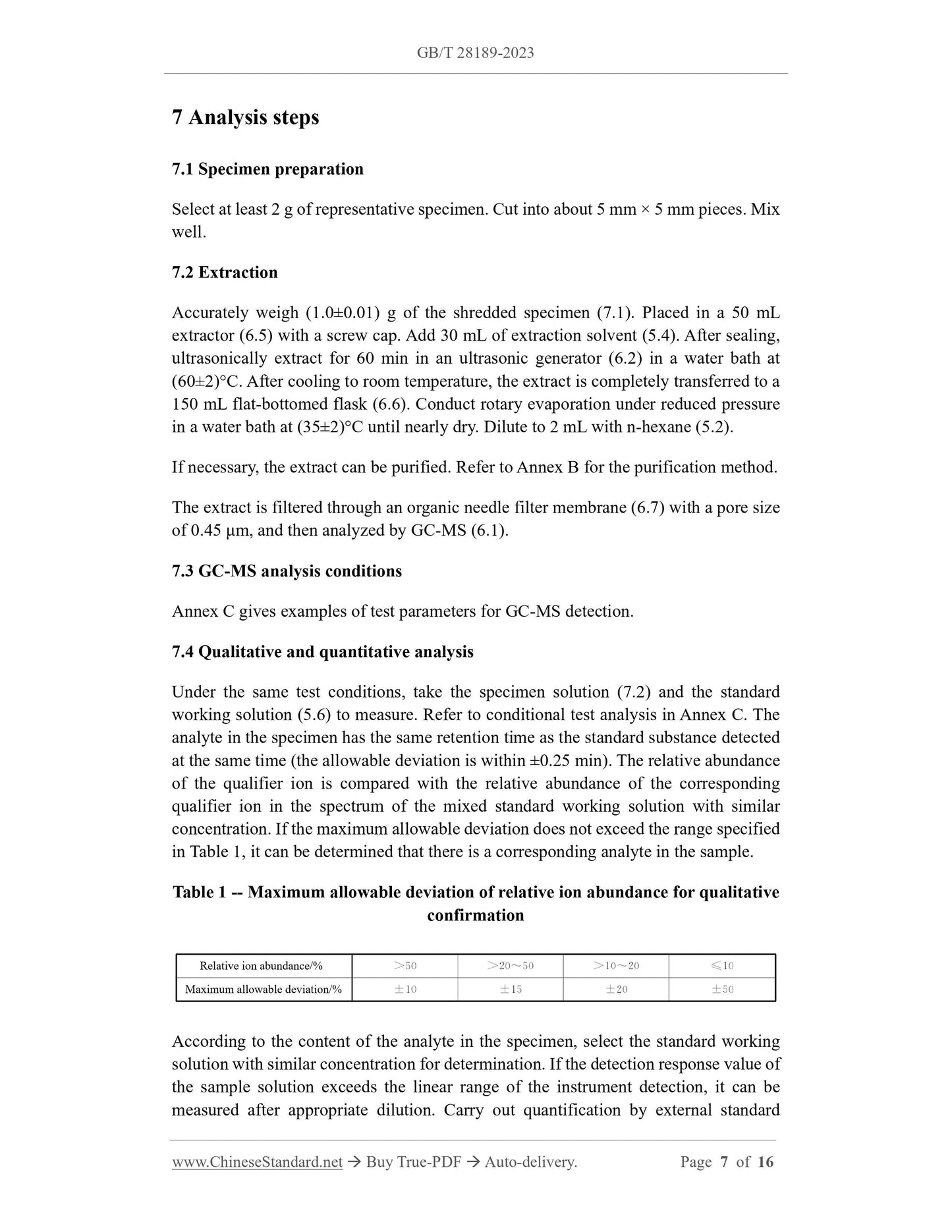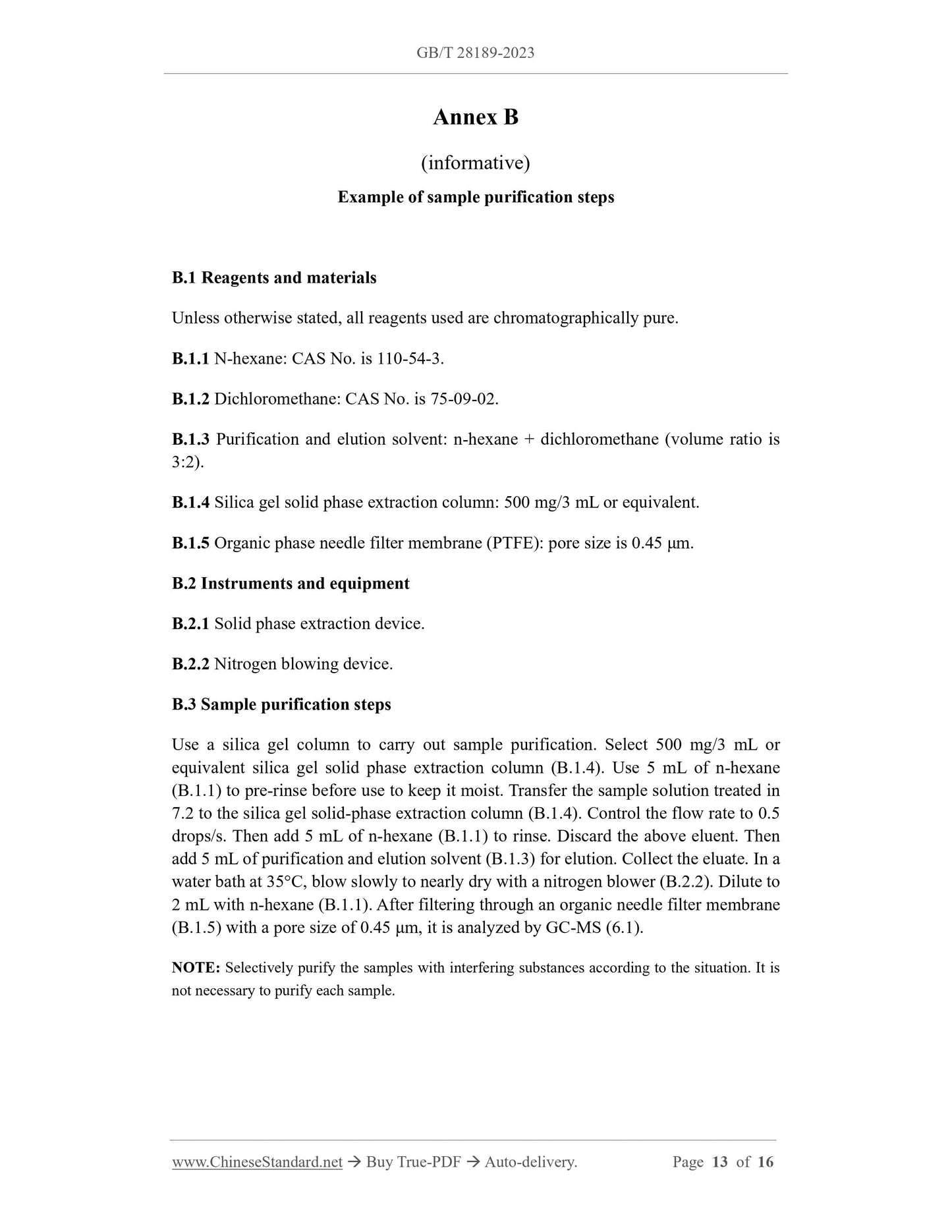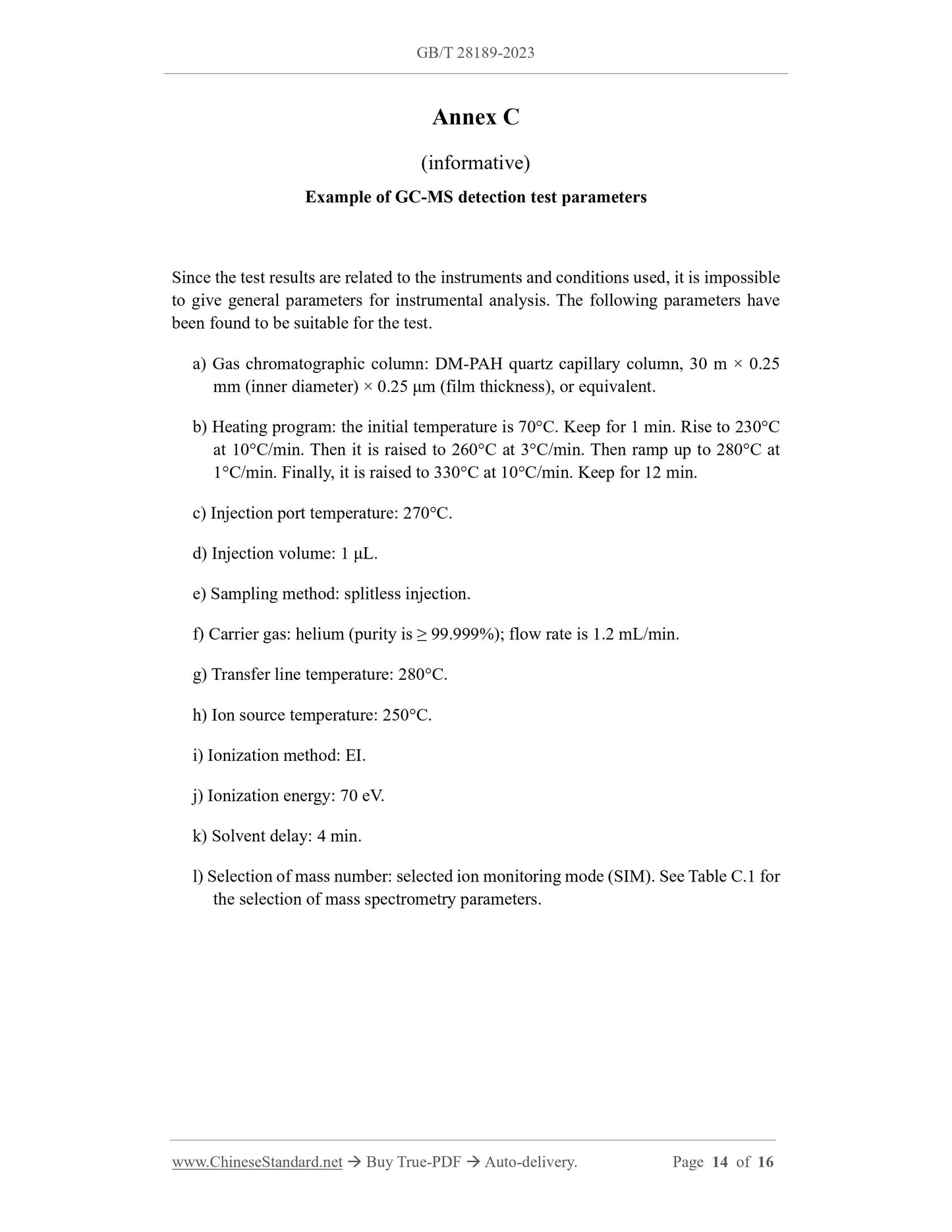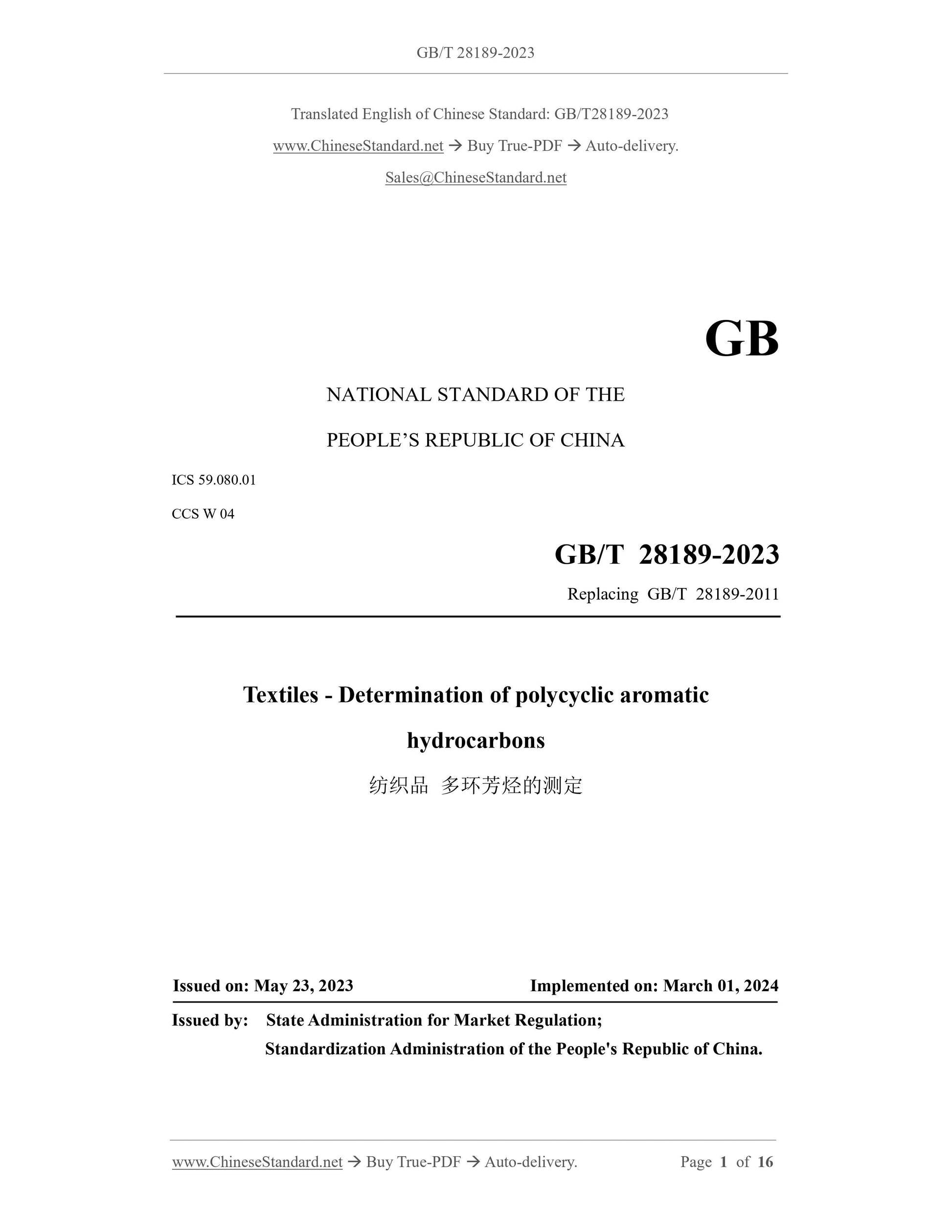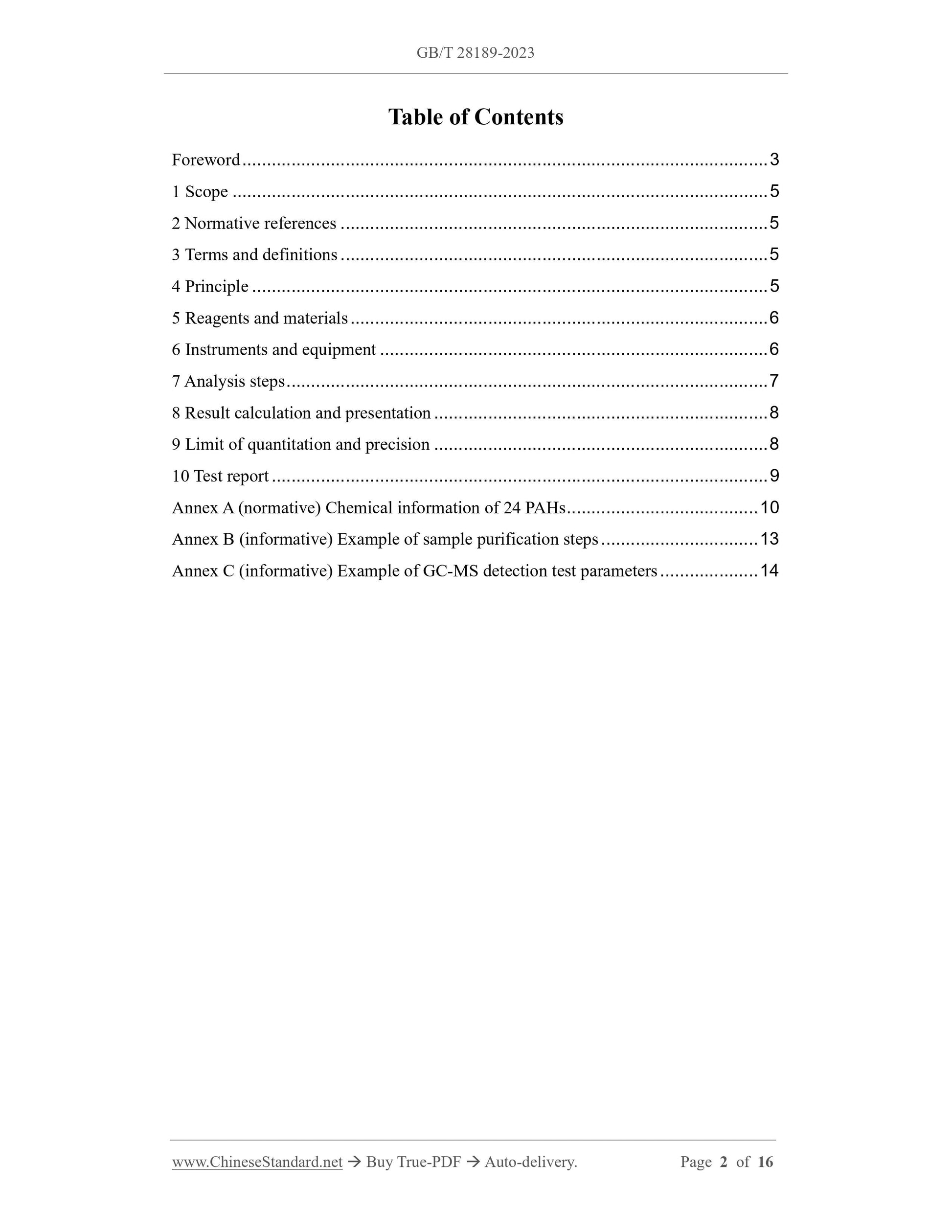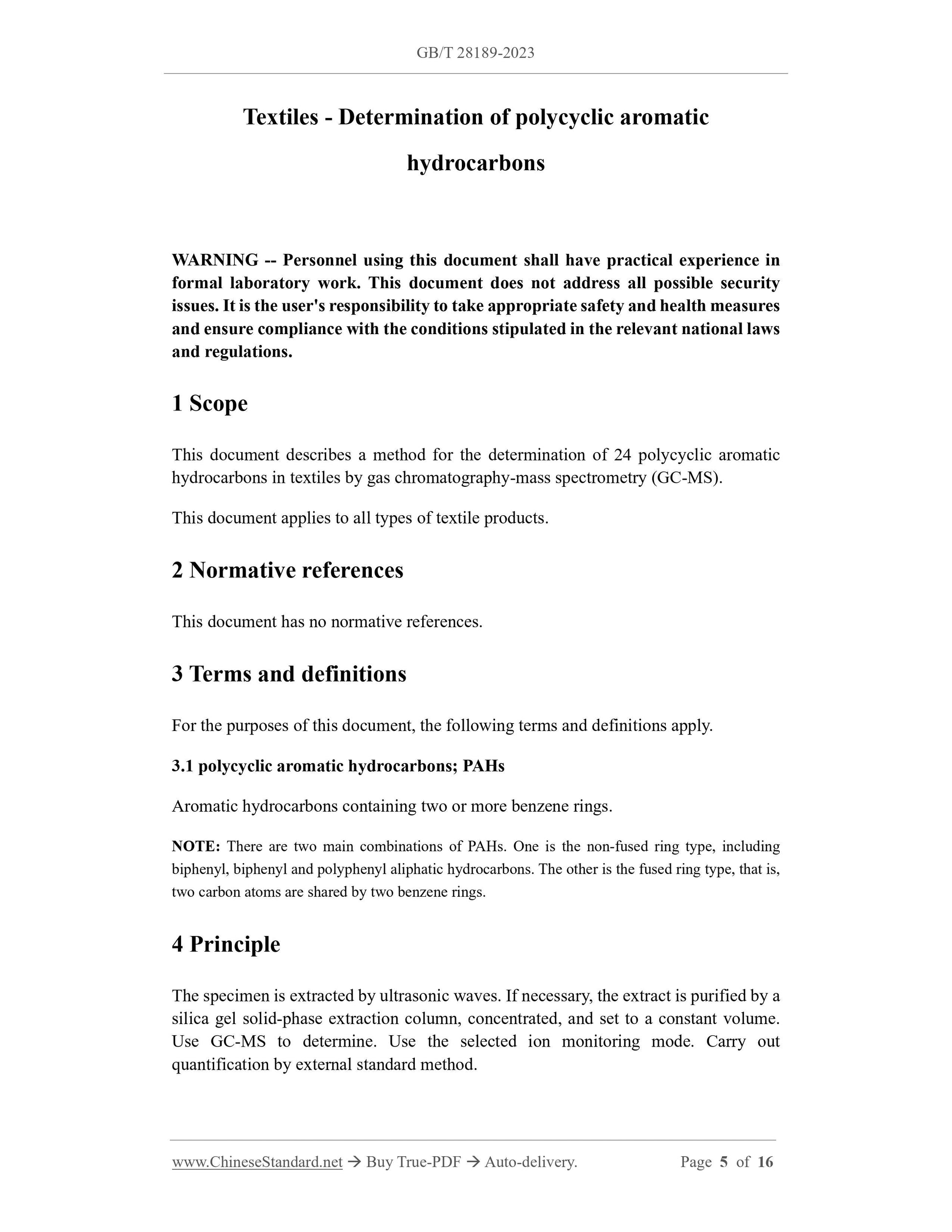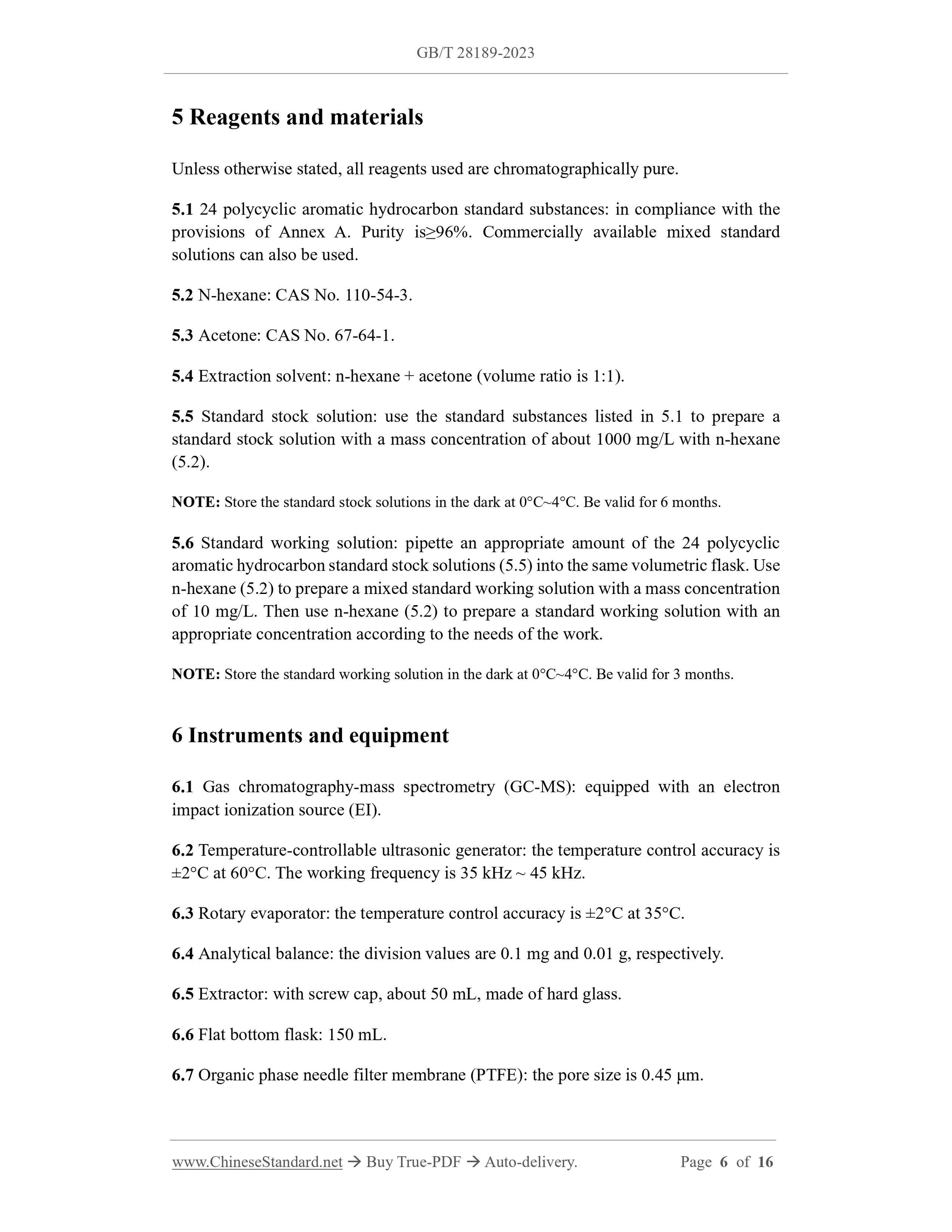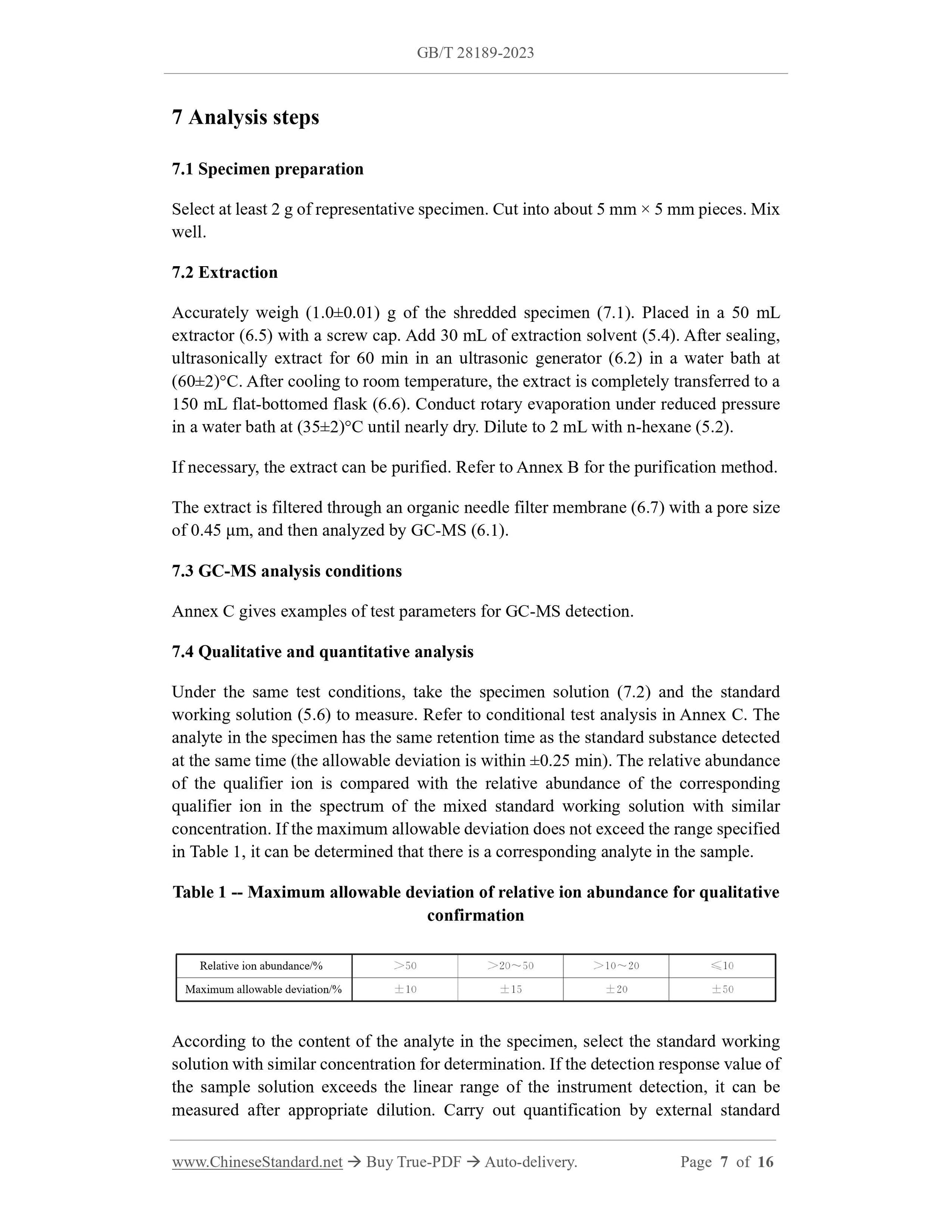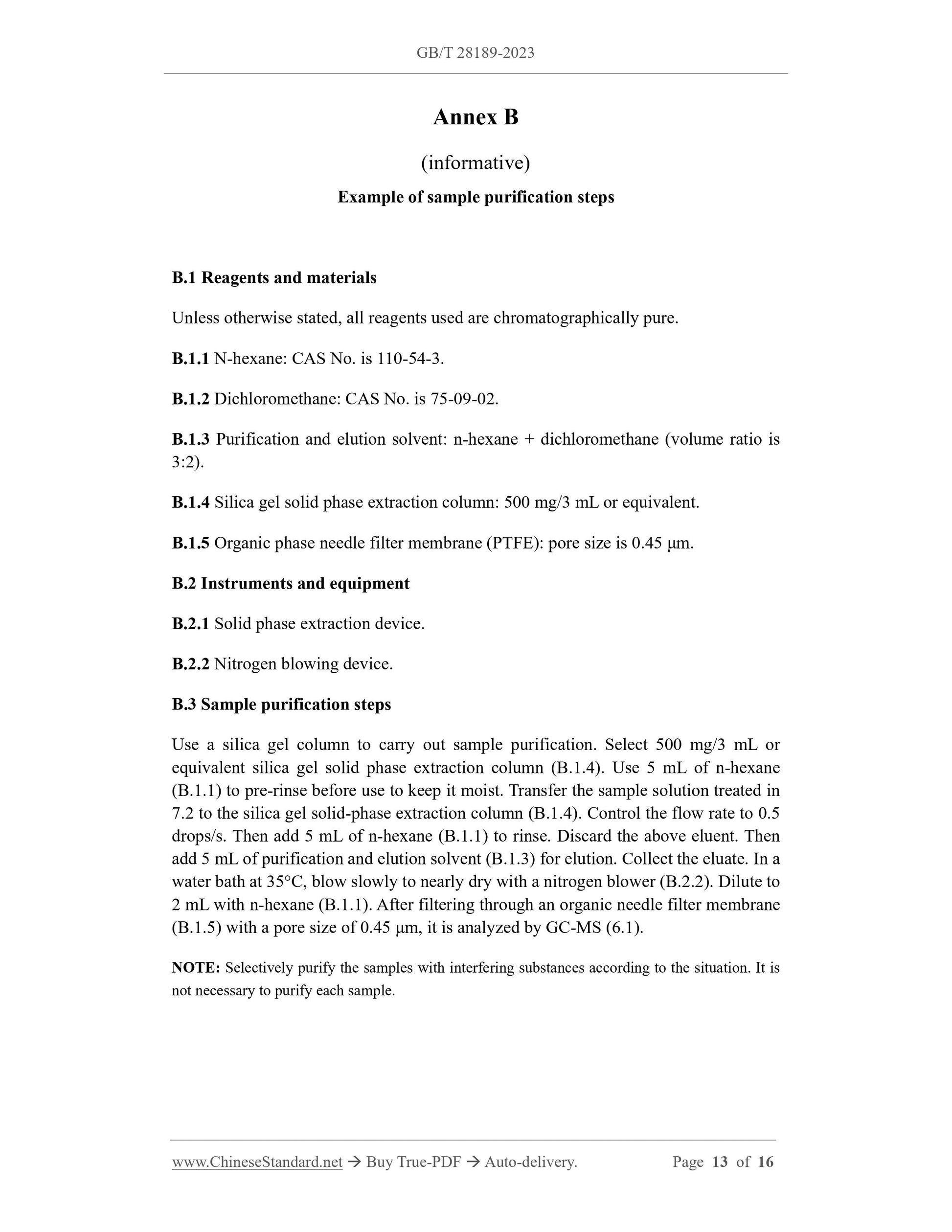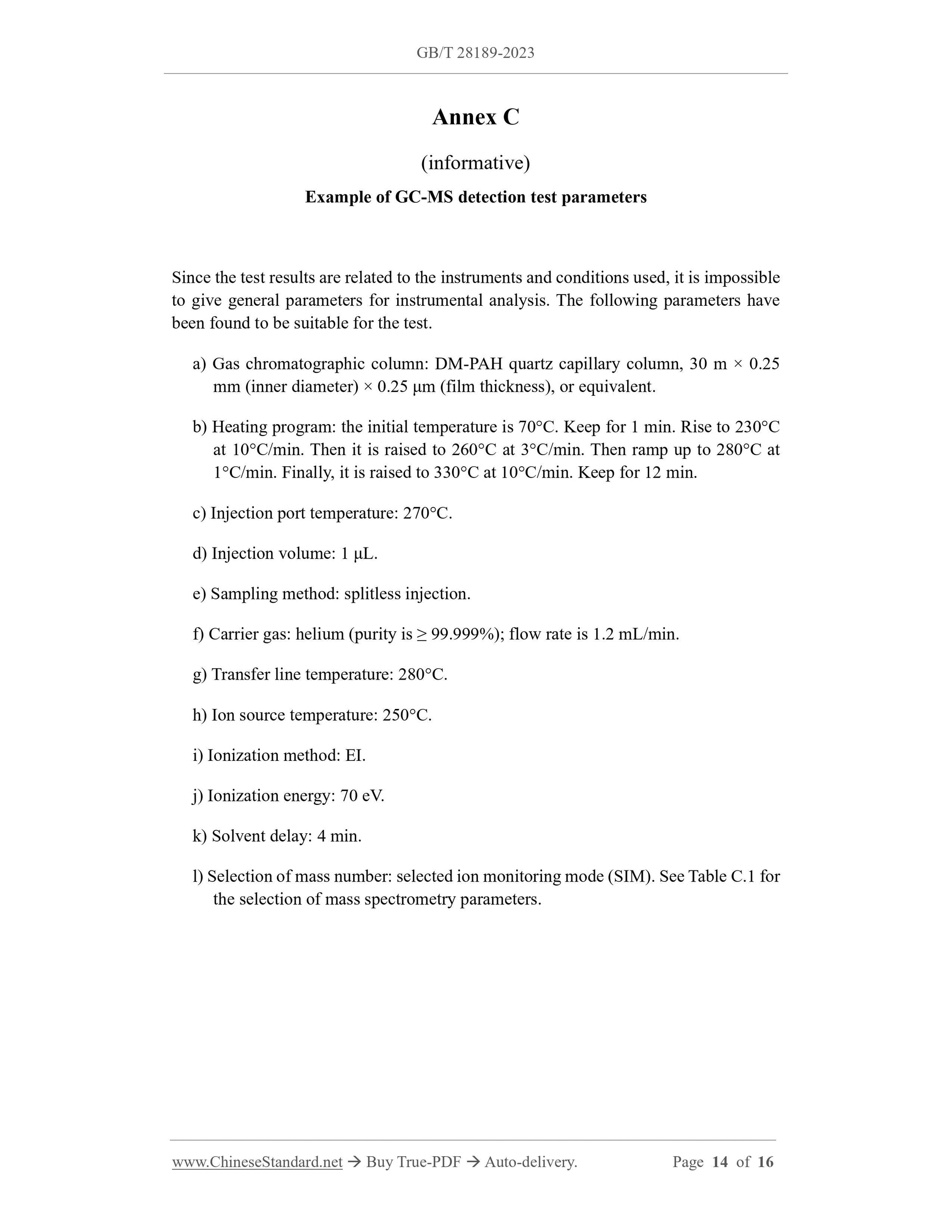1
/
su
7
PayPal, credit cards. Download editable-PDF and invoice in 1 second!
GB/T 28189-2023 English PDF (GBT28189-2023)
GB/T 28189-2023 English PDF (GBT28189-2023)
Prezzo di listino
$230.00 USD
Prezzo di listino
Prezzo scontato
$230.00 USD
Prezzo unitario
/
per
Spese di spedizione calcolate al check-out.
Impossibile caricare la disponibilità di ritiro
Delivery: 3 seconds. Download true-PDF + Invoice.
Get QUOTATION in 1-minute: Click GB/T 28189-2023
Historical versions: GB/T 28189-2023
Preview True-PDF (Reload/Scroll if blank)
GB/T 28189-2023: Textiles -- Determination of polycyclic aromatic hydrocarbons
GB/T 28189-2023
GB
NATIONAL STANDARD OF THE
PEOPLE’S REPUBLIC OF CHINA
ICS 59.080.01
CCS W 04
Replacing GB/T 28189-2011
Textiles - Determination of polycyclic aromatic
hydrocarbons
ISSUED ON: MAY 23, 2023
IMPLEMENTED ON: MARCH 01, 2024
Issued by: State Administration for Market Regulation;
Standardization Administration of the People's Republic of China.
Table of Contents
Foreword ... 3
1 Scope ... 5
2 Normative references ... 5
3 Terms and definitions ... 5
4 Principle ... 5
5 Reagents and materials ... 6
6 Instruments and equipment ... 6
7 Analysis steps ... 7
8 Result calculation and presentation ... 8
9 Limit of quantitation and precision ... 8
10 Test report ... 9
Annex A (normative) Chemical information of 24 PAHs ... 10
Annex B (informative) Example of sample purification steps ... 13
Annex C (informative) Example of GC-MS detection test parameters ... 14
Textiles - Determination of polycyclic aromatic
hydrocarbons
WARNING -- Personnel using this document shall have practical experience in
formal laboratory work. This document does not address all possible security
issues. It is the user's responsibility to take appropriate safety and health measures
and ensure compliance with the conditions stipulated in the relevant national laws
and regulations.
1 Scope
This document describes a method for the determination of 24 polycyclic aromatic
hydrocarbons in textiles by gas chromatography-mass spectrometry (GC-MS).
This document applies to all types of textile products.
2 Normative references
This document has no normative references.
3 Terms and definitions
For the purposes of this document, the following terms and definitions apply.
3.1 polycyclic aromatic hydrocarbons; PAHs
Aromatic hydrocarbons containing two or more benzene rings.
NOTE: There are two main combinations of PAHs. One is the non-fused ring type, including
biphenyl, biphenyl and polyphenyl aliphatic hydrocarbons. The other is the fused ring type, that is,
two carbon atoms are shared by two benzene rings.
4 Principle
The specimen is extracted by ultrasonic waves. If necessary, the extract is purified by a
silica gel solid-phase extraction column, concentrated, and set to a constant volume.
Use GC-MS to determine. Use the selected ion monitoring mode. Carry out
quantification by external standard method.
5 Reagents and materials
Unless otherwise stated, all reagents used are chromatographically pure.
5.1 24 polycyclic aromatic hydrocarbon standard substances: in compliance with the
provisions of Annex A. Purity is≥96%. Commercially available mixed standard
solutions can also be used.
5.2 N-hexane: CAS No. 110-54-3.
5.3 Acetone: CAS No. 67-64-1.
5.4 Extraction solvent: n-hexane + acetone (volume ratio is 1:1).
5.5 Standard stock solution: use the standard substances listed in 5.1 to prepare a
standard stock solution with a mass concentration of about 1000 mg/L with n-hexane
(5.2).
NOTE: Store the standard stock solutions in the dark at 0°C~4°C. Be valid for 6 months.
5.6 Standard working solution: pipette an appropriate amount of the 24 polycyclic
aromatic hydrocarbon standard stock solutions (5.5) into the same volumetric flask. Use
n-hexane (5.2) to prepare a mixed standard working solution with a mass concentration
of 10 mg/L. Then use n-hexane (5.2) to prepare a standard working solution with an
appropriate concentration according to the needs of the work.
NOTE: Store the standard working solution in the dark at 0°C~4°C. Be valid for 3 months.
6 Instruments and equipment
6.1 Gas chromatography-mass spectrometry (GC-MS): equipped with an electron
impact ionization source (EI).
6.2 Temperature-controllable ultrasonic generator: the temperature control accuracy is
±2°C at 60°C. The working frequency is 35 kHz ~ 45 kHz.
6.3 Rotary evaporator: the temperature control accuracy is ±2°C at 35°C.
6.4 Analytical balance: the division values are 0.1 mg and 0.01 g, respectively.
6.5 Extractor: with screw cap, about 50 mL, made of hard glass.
6.6 Flat bottom flask: 150 mL.
6.7 Organic phase needle filter membrane (PTFE): the pore size is 0.45 μm.
7 Analysis steps
7.1 Specimen preparation
Select at least 2 g of representative specimen. Cut into about 5 mm × 5 mm pieces. Mix
well.
7.2 Extraction
Accurately weigh (1.0±0.01) g of the shredded specimen (7.1). Placed in a 50 mL
extractor (6.5) with a screw cap. Add 30 mL of extraction solvent (5.4). After sealing,
ultrasonically extract for 60 min in an ultrasonic generator (6.2) in a water bath at
(60±2)°C. After cooling to room temperature, the extract is completely transferred to a
150 mL flat-bottomed flask (6.6). Conduct rotary evaporation under reduced pressure
in a water bath at (35±2)°C until nearly dry. Dilute to 2 mL with n-hexane (5.2).
If necessary, the extract can be purified. Refer to Annex B for the purification method.
The extract is filtered through an organic needle filter membrane (6.7) with a pore size
of 0.45 μm, and then analyzed by GC-MS (6.1).
7.3 GC-MS analysis conditions
Annex C gives examples of test parameters for GC-MS detection.
7.4 Qualitative and quantitative analysis
Under the same test conditions, take the specimen solution (7.2) and the standard
working solution (5.6) to measure. Refer to conditional test analysis in Annex C. The
analyte in the specimen has the same retention time as the standard substance detected
at the same time (the allowable deviation is within ±0.25 min). The relative abundance
of the qualifier ion is compared with the relative abundance of the corresponding
qualifier ion in the spectrum of the mixed standard working solution with similar
concentration. If the maximum allowable deviation does not exceed the range specified
in Table 1, it can be determined that there is a corresponding analyte in the sample.
Table 1 -- Maximum allowable deviation of relative ion abundance for qualitative
confirmation
According to the content of the analyte in the specimen, select the standard working
solution with similar concentration for determination. If the detection response value of
the sample solution exceeds the linear range of the instrument detection, it can be
measured after appropriate dilution. Carry out quantification by external standard
Relative ion abundance/%
Maximum allowable deviation/%
Annex B
(informative)
Example of sample purification steps
B.1 Reagents and materials
Unless otherwise stated, all reagents used are chromatographically pure.
B.1.1 N-hexane: CAS No. is 110-54-3.
B.1.2 Dichloromethane: CAS No. is 75-09-02.
B.1.3 Purification and elution solvent: n-hexane + dichloromethane (volume ratio is
3:2).
B.1.4 Silica gel solid phase extraction column: 500 mg/3 mL or equivalent.
B.1.5 Organic phase needle filter membrane (PTFE): pore size is 0.45 μm.
B.2 Instruments and equipment
B.2.1 Solid phase extraction device.
B.2.2 Nitrogen blowing device.
B.3 Sample purification steps
Use a silica gel column to carry out sample purification. Select 500 mg/3 mL or
equivalent silica gel solid phase extraction column (B.1.4). Use 5 mL of n-hexane
(B.1.1) to pre-rinse before use to keep it moist. Transfer the sample solution treated in
7.2 to the silica gel solid-phase extraction column (B.1.4). Control the flow rate to 0.5
drops/s. Then add 5 mL of n-hexane (B.1.1) to rinse. Discard the above eluent. Then
add 5 mL of purification and elutio...
Get QUOTATION in 1-minute: Click GB/T 28189-2023
Historical versions: GB/T 28189-2023
Preview True-PDF (Reload/Scroll if blank)
GB/T 28189-2023: Textiles -- Determination of polycyclic aromatic hydrocarbons
GB/T 28189-2023
GB
NATIONAL STANDARD OF THE
PEOPLE’S REPUBLIC OF CHINA
ICS 59.080.01
CCS W 04
Replacing GB/T 28189-2011
Textiles - Determination of polycyclic aromatic
hydrocarbons
ISSUED ON: MAY 23, 2023
IMPLEMENTED ON: MARCH 01, 2024
Issued by: State Administration for Market Regulation;
Standardization Administration of the People's Republic of China.
Table of Contents
Foreword ... 3
1 Scope ... 5
2 Normative references ... 5
3 Terms and definitions ... 5
4 Principle ... 5
5 Reagents and materials ... 6
6 Instruments and equipment ... 6
7 Analysis steps ... 7
8 Result calculation and presentation ... 8
9 Limit of quantitation and precision ... 8
10 Test report ... 9
Annex A (normative) Chemical information of 24 PAHs ... 10
Annex B (informative) Example of sample purification steps ... 13
Annex C (informative) Example of GC-MS detection test parameters ... 14
Textiles - Determination of polycyclic aromatic
hydrocarbons
WARNING -- Personnel using this document shall have practical experience in
formal laboratory work. This document does not address all possible security
issues. It is the user's responsibility to take appropriate safety and health measures
and ensure compliance with the conditions stipulated in the relevant national laws
and regulations.
1 Scope
This document describes a method for the determination of 24 polycyclic aromatic
hydrocarbons in textiles by gas chromatography-mass spectrometry (GC-MS).
This document applies to all types of textile products.
2 Normative references
This document has no normative references.
3 Terms and definitions
For the purposes of this document, the following terms and definitions apply.
3.1 polycyclic aromatic hydrocarbons; PAHs
Aromatic hydrocarbons containing two or more benzene rings.
NOTE: There are two main combinations of PAHs. One is the non-fused ring type, including
biphenyl, biphenyl and polyphenyl aliphatic hydrocarbons. The other is the fused ring type, that is,
two carbon atoms are shared by two benzene rings.
4 Principle
The specimen is extracted by ultrasonic waves. If necessary, the extract is purified by a
silica gel solid-phase extraction column, concentrated, and set to a constant volume.
Use GC-MS to determine. Use the selected ion monitoring mode. Carry out
quantification by external standard method.
5 Reagents and materials
Unless otherwise stated, all reagents used are chromatographically pure.
5.1 24 polycyclic aromatic hydrocarbon standard substances: in compliance with the
provisions of Annex A. Purity is≥96%. Commercially available mixed standard
solutions can also be used.
5.2 N-hexane: CAS No. 110-54-3.
5.3 Acetone: CAS No. 67-64-1.
5.4 Extraction solvent: n-hexane + acetone (volume ratio is 1:1).
5.5 Standard stock solution: use the standard substances listed in 5.1 to prepare a
standard stock solution with a mass concentration of about 1000 mg/L with n-hexane
(5.2).
NOTE: Store the standard stock solutions in the dark at 0°C~4°C. Be valid for 6 months.
5.6 Standard working solution: pipette an appropriate amount of the 24 polycyclic
aromatic hydrocarbon standard stock solutions (5.5) into the same volumetric flask. Use
n-hexane (5.2) to prepare a mixed standard working solution with a mass concentration
of 10 mg/L. Then use n-hexane (5.2) to prepare a standard working solution with an
appropriate concentration according to the needs of the work.
NOTE: Store the standard working solution in the dark at 0°C~4°C. Be valid for 3 months.
6 Instruments and equipment
6.1 Gas chromatography-mass spectrometry (GC-MS): equipped with an electron
impact ionization source (EI).
6.2 Temperature-controllable ultrasonic generator: the temperature control accuracy is
±2°C at 60°C. The working frequency is 35 kHz ~ 45 kHz.
6.3 Rotary evaporator: the temperature control accuracy is ±2°C at 35°C.
6.4 Analytical balance: the division values are 0.1 mg and 0.01 g, respectively.
6.5 Extractor: with screw cap, about 50 mL, made of hard glass.
6.6 Flat bottom flask: 150 mL.
6.7 Organic phase needle filter membrane (PTFE): the pore size is 0.45 μm.
7 Analysis steps
7.1 Specimen preparation
Select at least 2 g of representative specimen. Cut into about 5 mm × 5 mm pieces. Mix
well.
7.2 Extraction
Accurately weigh (1.0±0.01) g of the shredded specimen (7.1). Placed in a 50 mL
extractor (6.5) with a screw cap. Add 30 mL of extraction solvent (5.4). After sealing,
ultrasonically extract for 60 min in an ultrasonic generator (6.2) in a water bath at
(60±2)°C. After cooling to room temperature, the extract is completely transferred to a
150 mL flat-bottomed flask (6.6). Conduct rotary evaporation under reduced pressure
in a water bath at (35±2)°C until nearly dry. Dilute to 2 mL with n-hexane (5.2).
If necessary, the extract can be purified. Refer to Annex B for the purification method.
The extract is filtered through an organic needle filter membrane (6.7) with a pore size
of 0.45 μm, and then analyzed by GC-MS (6.1).
7.3 GC-MS analysis conditions
Annex C gives examples of test parameters for GC-MS detection.
7.4 Qualitative and quantitative analysis
Under the same test conditions, take the specimen solution (7.2) and the standard
working solution (5.6) to measure. Refer to conditional test analysis in Annex C. The
analyte in the specimen has the same retention time as the standard substance detected
at the same time (the allowable deviation is within ±0.25 min). The relative abundance
of the qualifier ion is compared with the relative abundance of the corresponding
qualifier ion in the spectrum of the mixed standard working solution with similar
concentration. If the maximum allowable deviation does not exceed the range specified
in Table 1, it can be determined that there is a corresponding analyte in the sample.
Table 1 -- Maximum allowable deviation of relative ion abundance for qualitative
confirmation
According to the content of the analyte in the specimen, select the standard working
solution with similar concentration for determination. If the detection response value of
the sample solution exceeds the linear range of the instrument detection, it can be
measured after appropriate dilution. Carry out quantification by external standard
Relative ion abundance/%
Maximum allowable deviation/%
Annex B
(informative)
Example of sample purification steps
B.1 Reagents and materials
Unless otherwise stated, all reagents used are chromatographically pure.
B.1.1 N-hexane: CAS No. is 110-54-3.
B.1.2 Dichloromethane: CAS No. is 75-09-02.
B.1.3 Purification and elution solvent: n-hexane + dichloromethane (volume ratio is
3:2).
B.1.4 Silica gel solid phase extraction column: 500 mg/3 mL or equivalent.
B.1.5 Organic phase needle filter membrane (PTFE): pore size is 0.45 μm.
B.2 Instruments and equipment
B.2.1 Solid phase extraction device.
B.2.2 Nitrogen blowing device.
B.3 Sample purification steps
Use a silica gel column to carry out sample purification. Select 500 mg/3 mL or
equivalent silica gel solid phase extraction column (B.1.4). Use 5 mL of n-hexane
(B.1.1) to pre-rinse before use to keep it moist. Transfer the sample solution treated in
7.2 to the silica gel solid-phase extraction column (B.1.4). Control the flow rate to 0.5
drops/s. Then add 5 mL of n-hexane (B.1.1) to rinse. Discard the above eluent. Then
add 5 mL of purification and elutio...
Share
